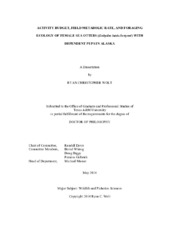| dc.description.abstract | Sea otter (Enhydra lutris kenyoni) foraging behavior and prey preference (2001-
2004) and the behavior and activity budgets of females with dependent pups (2005-
2010) were studied during the summer (June-August) in Simpson Bay, Prince William
Sound, Alaska. Unlike most previous studies of sea otters which were conducted in
coastal areas with a rocky benthos and kelp canopy, the benthic habitat in this study was
primarily soft sediment (mud or mixed mud and gravel) with no canopy-forming kelps.
Foraging behavior and prey preference. A total of 1,816 foraging dives from 211
bouts were recorded. 87% of foraging dives were successful, and 44% of the prey was
identified: 75% clams, 9% Pacific blue mussels, 6% crabs, 2% scallops and a variety of
other invertebrates. Significantly more prey items/area were brought up from mixed
mud/gravel than mud (p-value <0.0001). Sea otters in Simpson Bay have relied heavily
on bivalves for the past 20 years, and the summer population has been constant for at
least the past twelve years. It appears that bivalves are the predominant and stable
component of the diet, and their productivity is sufficient to sustain a stable population
of sea otters with a peak summer density of 4.3 adult otters km^(-2) for the past twelve
years and probably longer.
Behavior and activity budgets of females with dependent pups. Females with
dependent pups spent the greatest percentage of the day resting (42%), about equal
percentages foraging (18%), grooming (15%) and swimming (15%), and the remainder
swimming slowly (8%) and interacting (2%). The estimated FMR was 12.69 MJ day^(-1).
Sea otters reoccupied the study area in the early 1980s, and the population has been
stable for over a decade. However, the time spent foraging is more similar to areas that
have been recently occupied. The relatively small amount of time spent foraging may
indicate that geographic differences (structure of the near-shore community: substrate,
water depth, kelp canopy, prey assemblage, and competitors) may play a greater role in
determining the amount of time spent foraging than population status. | en |


